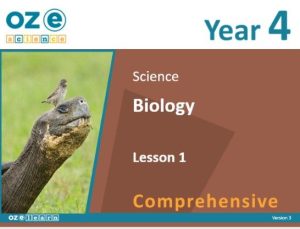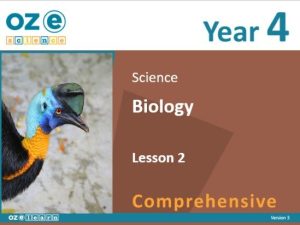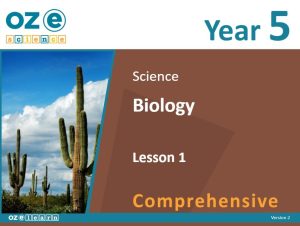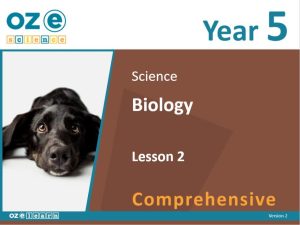Oz-e-science
Biology Comprehensive Years F–6
Oz-e-science: Biology Comprehensive units align to the Australian Curriculum Content Descriptions
Free Starter Lessons
Year Overview
Year 4
Australian Curriculum Content Descriptions
Overview
Biology Comprehensive Year 4 is a Biological Sciences curriculum program for Year 4 students. It aligns to the Australian Curriculum Science Understanding:
- Living things depend on each other and the environment to survive (ACSSU074).
- Living things have life cycles (ACSSU072).
Note: This curriculum program is currently being updated to align with the Australian Curriculum 9.0. Updated versions will be released in early 2024.
Learning Objectives
In Lessons 1 to 15 students learn about:
- symbiotic relationships where both living things benefit – mutualism
- symbiotic relationships between animals and plants/algae where both benefit – mutualism
- symbiotic relationships between flowering plants and pollinators where both living things benefit – mutualism
- the three steps to asking questions about the world around us
- symbiotic relationships where one animal benefits and the other animal doesn’t and is not harmed – commensalism
- the scientific method Charles Darwin followed when he observed, questioned and hypothesised about the possible pollinator of an unusual plant
- symbiotic relationships where one living thing is harmed – parasitism
- predator/prey relationships
- the life cycles of plants
- the life cycles of animals
- the process of metamorphosis
- the field trip and how to plan
- how to write a script to use in their documentary using information gathered from the field trip
- how to plan an expo to communicate to others what was learned about their chosen specimen.
Success Criteria
- Report on a mutual relationship between two living things.
- Classify mutual relationships in a matching game.
- Sequence the steps of pollinations in a storyboard.
- Explain the three steps to developing questions.
- Observe, question and hypothesise as Charles Darwin did.
- Describe predator/prey relationships between two living things.
- Write a short report on a predator/prey relationship.
- Design a predator.
- Write a short report about the life cycle of the Galapagos tortoise.
- Plan a field trip.
- Create a short documentary on an iPad.
- Plan an expo to communicate to others about a chosen specimen.
Assessment
Progress Tests
Progress tests are conducted after every second lesson, allowing teachers to monitor student understanding of the concepts taught over the past two lessons and to identify where reteaching is needed. The Teaching Guide contains the testing questions, and the Student Workbook has a section where students write their answers and score themselves.
Structured Research Activity
The Structured Research Activity (SRA) for this unit is:
Students create and present a mini documentary about a living thing. The SRA takes place over two lessons so students can apply the Science Understanding and Science Inquiry Skills covered in the unit. Teachers use the Guide to Making Judgements, which is included in the Teaching Guide, to mark the SRA.
End-of-Unit Assessment
The last lesson is the end-of-unit assessment, which has a variety of question formats (e.g. label the diagram, circle the correct answer) to assess student mastery of content from the unit. The end-of-unit assessment is in the Teaching Guide. Teachers copy the assessment and distribute to students at testing time.
Year 5
Australian Curriculum Content Descriptions
Overview
Biology Comprehensive Year 5 is a Biological Sciences curriculum program for Year 5 students. It aligns to the Australian Curriculum Science Understanding:
- Living things have structural features and adaptations that help them survive in their environment (ACSSU043).
Note: This curriculum program is currently being updated to align with the Australian Curriculum 9.0. Updated versions will be released in early 2024.
Learning Objectives
In Lessons 1 to 15 students learn about:
- how life started as a single cell
- what genes are
- the species that form Earth’s biodiversity
- how different environments have different physical conditions
- natural selection and adaptations
- the adaptations to biological conditions in the environment
- how species have adapted to live in extreme conditions, for example on land
- how living things survive in extreme dry conditions
- how living things survive in extreme cold conditions
- how living things survive in other extreme conditions
- how every living thing is adapted to its environment and how to find out the conditions of an environment
- using the scientific method to find out which animals and plants live in the local environment
- conducting research in the schoolyard to find out which animals and plants live there and to observe their adaptations
- how to explain and evaluate the results of the research about the adaptations of living things the area
- how to report their findings from their investigation and communicate them to an audience.
Success Criteria
- Explain what genes are and where they are found.
- Explain what genetic diversity means.
- Describe how scientists sort and classify the huge diversity of living things.
- Sort physical from biological conditions.
- Describe how environments differ in their physical conditions.
- Explain what natural selection is.
- Explain what an adaptation is.
- Explain what an extreme environment is.
- Explain why extreme conditions make it difficult to survive.
- Describe the adaptations to survive in extreme conditions.
- Research the climate and weather data for the local environment.
- Research which types of living things live in their schoolyard.
- Observe and record the adaptations that living things in the schoolyard might have.
- Explain the results of their investigation.
- Report the results of their investigation.
Assessment
Progress Tests
Progress tests are conducted after every second lesson, allowing teachers to monitor student understanding of the concepts taught over the past two lessons and to identify where reteaching is needed. The Teaching Guide contains the testing questions, and the Student Workbook has a section where students write their answers and score themselves.
Structured Research Activity
The Structured Research Activity (SRA) for this unit is:
Students observe, record, research and report on at least two plants and two animals and their adaptations. The SRA takes place over two lessons so students can apply the Science Understanding and Science Inquiry Skills covered in the unit. Teachers use the Guide to Making Judgements, which is included in the Teaching Guide, to mark the SRA.
End-of-Unit Assessment
The last lesson is the end-of-unit assessment, which has a variety of question formats (e.g. label the diagram, circle the correct answer) to assess student mastery of content from the unit. The end-of-unit assessment is in the Teaching Guide. Teachers copy the assessment and distribute to students at testing time.
Year 6
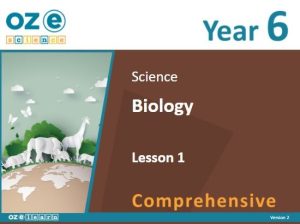
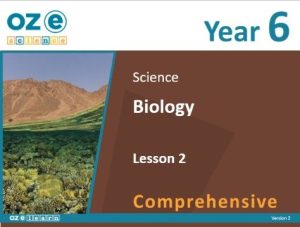
Teaching Resources
Extra resources
Australian Curriculum Content Descriptions
Overview
Biology Comprehensive Year 6 is a Biological Sciences curriculum program for Year 6 students. It aligns to the Australian Curriculum Science Understanding:
- The growth and survival of living things are affected by the physical conditions of their environment (ASCCU094)
Note: This curriculum program is currently being updated to align with the Australian Curriculum 9.0, updated versions will be released in early 2024.
Learning Objectives
In Lessons 1 to 15, students learn about:
- the unique conditions on Earth that have allowed the creation of life
- the characteristics of a living thing
- the conditions living things need in order to survive
- setting up an experiment to determine the effect of changing conditions on a plant species
- the steps of the scientific method
- the different types of microscopic life and the conditions they need to survive
- why controlling factors and conditions for growing bacteria and fungi is important for our own survival
- the effects of the coronavirus and how it affects humans
- the effect temperature has on the survival of living things
- energy sources and chemical conditions required for living things to survive
- an experiment to determine the effect of changing conditions on a plant species
- how to explain, evaluate, and communicate the results of an experiment to determine the effect of changing conditions on a plant species
- examples of humans controlling the survival of other living things
- what ethics are and communicating opinions on the ethics of manipulating survival
- constructing an argument to use in a debate on the ethics of gene technology.
Success Criteria
- Identify the conditions on Earth that allowed life to form.
- Describe four theories about how life formed on Earth.
- Experiment with creating energy from mixing chemicals.
- Create a model of a living thing.
- Describe the conditions required for humans to survive.
- Identify different types of life that live in different conditions.
- Set up an experiment to test plant survival.
- Identify microorganisms in a sample of pond water.
- Explain how bacteria and fungi grow rapidly in in perfect conditions.
- Explain how viruses affect their host.
- Identify ways to protect against viruses.
- Investigate how herd immunity can control the spread of viruses.
- Identify the range of temperature conditions found on Earth.
- Investigate the effect that changing ocean chemicals is having on shellfish.
- Describe the result that changing a condition has on plant growth.
- Explain how humans have changed the conditions for survival of different living things.
- Describe the changes humans have made to the survival of living things to benefit us.
- Describe ways that humans have begun manipulating DNA to benefit us.
- Communicate opinions on the ethics of these decisions.
Assessment
Progress Tests
Progress tests are conducted after every second lesson, allowing teachers to monitor student understanding of the concepts taught over the past two lessons and to identify where reteaching is needed.
The Teaching Guide contains the testing questions, and the Student Workbook has a section where students write their answers and score themselves.
Structured Research Activity
The Structured Research Activity (SRA) for this unit is:
Students conduct an experiment growing seeds and report on the effect of changing conditions on a plant species.
The SRA takes place over two lessons so students can apply the Science Understanding and Science Inquiry Skills covered in the unit.
Teachers use the Guide to Making Judgements, which is included in the Teaching Guide, to mark the SRA.
End-of-Unit Assessment
The last lesson is the end-of-unit assessment, which has a variety of question formats (e.g. label the diagram, circle the correct answer) to assess student mastery of content from the unit.
The end-of-unit assessment is in the Teaching Guide. Teachers copy the assessment and distribute to students at testing time.

